News and Updates from Phoenix Aura
Idle Space Navy Devnote XXXVIII

Kicking Off 0.11
July 6, 2024 (at least in the time zone I’m writing this post). Today is the 588th day since I’ve set off on the journey that has been Idle Space Navy. There was the disorganized fun of the pre-Steam period, the reality check of the Steam release, and steady improvements in the game since then. As much as some reviews drive me nuts with their complete lack of meaningful feedback, those that have left reviews and discussions on both Steam and in Discord have helped me hone my skills and redesign the game.
Now, with 10 major versions and 38 total versioned releases behind me, it’s time to take the next step and start the development of Idle Space Navy 0.11. There’s a lot being packed into this update, so I’m going to lay it out. (If you don’t want to read the planned changes, though, jump down to the “Milestone Program” header for information on my closed testing program.)
The fourth Alien Power. We have the Terran Union (damage and Kinetic weapons), the Centauri Conglomerate (scrap and credits), and the Commonwealth of Isara (Calibration Chips). Now, though, we’ll have the as-yet-unnamed 4th Alien Power, which will play a very significant role. At first glance, the fourth Power will only handle Experience gains – but there are big plans for this Power. It’s the first Power that will interact with the other three, boosting various aspects of their abilities depending on your Player Level (L). This does mean that the fourth Power will be the first to have an unlock requirement – you’ll have to be at least tier 3 in all three of the preceding Powers, and have a combined tier count of at least 11 (so two of the three Powers will have to be tier 4, or one will have to be tier 5).
Unlockable Ships and Weapons. The Terran Union has been the only Power with ships – your default ships come from the Terrans, as do the Frigate and Destroyer. Now, however, we’ll be getting Ships and upgraded Weapons available for unlock and then purchase from all the Alien Powers. There’s only going to be one or two ships (the X1Y1 ships) and one weapon for unlock to start with, but that’s because there will start to be Ship-based bonuses.
Shipyard cap boost upgrades. The main limitation keeping people from going further faster is that the Shipyard caps remain the same, making the Artifact boosts (which are currently small, and will also be rescaled upward) the only way to advance. Not anymore – there will be a new set of upgrades in the Artifact System which will boost the caps to your Shipyard Damage, Scrap, Credits, and XP upgrades depending on the Artifact upgrade’s level and your maximum level. What’s more is that these will be available as Tier 1 upgrades for all Alien Powers, making it all the easier to get much higher advancement more quickly.
Catch-Up System. In versions prior to 0.10.0, ship and weapon levels in the Lab were kept on Artifact collection. This was not intended and started to present a lot of balance issues, so these got nerfed by being reduced to their square root on every Artifact collection. However, that too ended up causing a lot of lag time when collecting, which also wasn’t intended. Starting in 0.11, there will be mechanics to use the removed levels in a Catch-Up System. More on this as it is developed.
New enemies and enemy effects. There are three new enemy types planned for 0.11 – Armored, Swarm, and Shield Generator. Armored enemies will have increased armor and health. Swarms will have four enemies in one space, each with a portion of health that’s greater than one standard enemy. Shield Generators are fragile, having minimal health, but they generate very strong Shields on themselves and moderately strong Shields around all other enemies. What are Shields? I’m glad you asked. Enemies will start to have Shielding, basically an extra reserve of health which can only be damaged by energy-based weapons. For now, Lasers and the new weapon type will be the only ways to damage Shields.
New weapon type. The new weapon type I mentioned is Disruption weapons. These are slow-firing with slow-moving projectiles, but they deal a significant premium of damage, and they not only damage Shields, but will partially pierce them and damage the ship on the other side. These will be useful against the heavily-shielded but low-health Shield Generator enemies.
Permanent Modules. New to ISN 0.11 will be the crafting of Permanent Modules. Unlike Temporary Modules, as the name suggests, they do not have an expiration time. They do have a weaker effect than the equivalent tier of Temporary Module (though module effects will all be strengthened in 0.11) in return, though, and require not only Module Points but also materials mined from Asteroids to manufacture.
Asteroids return! Earlier versions of ISN had a mechanic where Asteroids would be collected on sector clear, but they were horribly broken and so temporarily phased out for a few versions. Now, however, they are back, rebalanced, and much more stable. They’ll also have more variety – with not just Metal Ore (refinable into Ingots or Credits in 0.11), but also the resources you’ll need to craft the first Permanent Modules.
Other stuff. There’s a whole slew of UI and quality of life improvements planned, like the replacement of the Andromeda background with a moving starfield, modifications to the mission info pop-up, more information in the Info Codex, and a change to how sectors are named. There’s also going to be new items to purchase in Daily Rewards, Offline Progress, and the Neutron Hub. There’s also going to be updates to Milestone Achievements as well as test Minor Achievements. There’s more stuff planned for 0.11, so stay tuned!
Gee, Arynnia, this sounds like a lot. What’s the release date? For a couple of reasons, my current target is very vague – I’m hoping to have this out in September 2024, but it could be out in August or it could be out in the fourth quarter. The first major reason is that there is a lot planned for 0.11, but there’s also another project I’m working on – as well as a new program I have in mind to make sure that new releases aren’t as buggy that may draw out the release timeframe. Let’s go ahead and go into that.
The Milestone Program: Help Test Idle Space Navy!
Recent releases of Idle Space Navy have taught me that I simply do not have enough eyes to catch every single bug that crops up in an Idle Space Navy release. As such, I’ve decided to create a closed testing program known as the Milestone Program. This will be a small group of testers who receive access to early builds of ISN 0.11 (known as Milestone builds) to try new features individually as they are developed. I’m planning the initial population of the Milestone Program to be 3-5 testers, and my goal is to have at least one major Milestone build (a new feature being introduced) every week, but my plan is to not develop new features until features in testing are thoroughly reviewed.
I’ll be writing more on the Milestone Program (and announcing the opening of applications) in a separate post early next week, so stay tuned for that post – and for more Devnotes in the future as development of Idle Space Navy continues!
Studio Update June 2024 #2: What Does My Support Do?
Studio Update June 2024 #2
What Does My Support Do?
This studio update is going to be a bit more oriented toward the nuts and bolts of running Phoenix Aura as a business, and why I could always use more support in this creative journey.
First up, Idle Space Navy has been huge for me! I cannot stress this enough – ISN has brought in far more than I ever thought it would. We’re up to over $1,800 gross just since the launch of 0.09.0 in January – but there’s more that plays into what I actually receive than just this headline number. In fact, by the time Steam’s share, sales taxes, and state tax comes out, I’m often getting less than $200 a month from it – a very nice sum, but it actually isn’t enough to run Aura on ISN alone.
Fortunately, there’s more than one way to help out. I wanted to make sure that anyone who wanted to support the creative journey could do so – as such, I made sure there were multiple options. I’ll go into them after I show you what all it’s going for.
So, what does your support actually do?
It doesn’t go right into my pocket, that’s for sure. There’s a lot of expenses – nearly $3,000 a year – that have to come out before I see anything. Here’s what there is.
Stuff I can’t do anything without. Obviously, in order to run a business, there are licenses and requirements. There’s an annual filing requirement, and the requirement to retain a registered agent for the business as well. These, all told, come to about $365 a year, or about $30 a month. (I had to estimate my local license cost, as I moved in the middle of the license term, so this may actually be higher or lower by a few dollars.)
Making my games: certificates and stuff. Well, to be able to publish games, I have to have a code signing certificate. Two, in fact, because of course Windows and Mac don’t share infrastructure. Apple is actually the cheaper of the two this time (hilarious to think about), but for me to even be able to securely publish games is $490 a year, and it falls all in one month. There’s also publishing fees ($100 per app for Steam, and other amounts for other stores when I get there).
General art stuffs. Yes, I use Adobe. It’s what I learned, it’s what I’m best at. That costs a lot, but there’s also a need for material to use for intros and video music, as well as some stuff I might be able to use in other media. All told, my art stuff comes to $915 a year (over $75 a month!), which is by far the largest expense I face.
Stream and video specific stuff. Like the music? Yeah, that costs me money – $25 a month! I’m working on phasing this out (potentially) by building a playlist of free-to-stream music that I can use, but this takes time. There’s also the streaming software I use in the form of StreamLabs, which in and of itself has some features in its Prime subscription ($19 a month) that I utilize. All told, it gets pulled to $528 a year.
Keeping the website up. I’m actually in the process of moving to a self-hosted solution, which will likely make this somewhat cheaper in the long run as I move from having to pay for a domain and hosting to just paying for a domain and the website tools. Nevertheless, right now, it’s $609 a year for all the stuff (about $51 a month).
Stuff that doesn’t fit. Obviously, working on computers, things break. I need to have money on hand to replace or upgrade my computer when that happens. I also have to deal with such things as state taxes (usually about $200 a year) – though fortunately not federal (it gets rolled onto my personal taxes, which I already have extra money pulled out of my salary to handle – I am not a tax fraud, don’t fret).
How can you help?
Join the Phoenix Flight through Patreon, StreamLabs, or Discord (coming soon). The best way to support the creative journey is to become a monthly supporter and join the Phoenix Flight. There are three ways to do this – become a Patron on my Patreon page ($2 or more a month), support me monthly on my StreamLabs page ($1 or more a month), or (coming soon) get one of the Phoenix Flight roles from the Phoenix Aura Discord (prices TBD). There’s also likely to be a Ko-fi page coming soon as well.
Tip one time through StreamLabs or Buy Me A Coffee. For those of you who want to support me one time, there’s my StreamLabs page again ($1 or more) or the older Buy Me A Coffee page – in my case, a Buy Me Some Strawberries page ($3 per strawberry).
Buy Neutron Stars in Idle Space Navy. ISN isn’t pay to win – you can earn Neutron Stars through Milestone Achievements and Daily Rewards, but supporting me there is an option as well. You can find Idle Space Navy on Steam – it’s free to play!
Subscribe to my blog, Thoughts of Phoenix. It’s new, but I’m looking forward to doing it. I’ve already made two posts, and I’m going to be making new free posts every week to ten days and paid posts (once there’s a membership) more often than that.
Subscribe through Twitch or cheer some Bits. Now, I don’t recommend these because Twitch takes a huge cut – I get maybe 45% of every Twitch subscription, as opposed to 80-85% of every Patreon subscription or more than 90% of every StreamLabs tip. That being said, it is an option on my Twitch to subscribe or cheer with Bits, especially if you have Amazon Prime or Twitch Prime – which gives you a free sub token every month!
More coming soon. I’m working on new things I might be able to do, such as more games, some digital content, and other ways to tip or support me and receive stuff like credit in videos or behind-the-scenes stuff.
Nothing is required, but every bit of support is hugely appreciated.
Your support helps me focus more on making good content and worry less about where the money to run the business comes from. I’d love to be able to move toward doing stuff full time, and this will help me reach that goal as well. I am immensely grateful to everyone who chooses to support this creative journey in any manner or amount, and still just as grateful to those who enjoy the content even if they can’t actively support it.
For now, though, see you in future endeavors!
Studio Update June 2024: Whoa, Things Are Happening!
Phoenix Aura Studio Update June 2024
Whoa, Stuff is Happening!
It’s been a while since I’ve had a general studio update as opposed to an ISN Devnote, so I figure it’s time to talk about the state of things and future plans.
Idle Space Navy. Version 0.10.7 is out now, and a patch to it will be coming out in the morning or early afternoon to fix something weird that cropped up. I’m pretty confident that this will make the 0.10 sequence stable, and so attention will be turning to 0.11. I plan on taking June off from active development on ISN just to let the game earn some playtime and more feedback on the updates in 0.10, but I plan to start development on the 0.11 sequence at some point in July for a mid-August launch. More details on the early plans for 0.11 will be coming in a Devnote soon.
What will I be doing in the meantime? Well, there’s a few things I’ve been meaning to work on. For starters, I’m going to be testing a move of the website onto a self-hosted solution (and updating the content on it), as well as rolling out a wiki for Idle Space Navy and future games. Second, I’m working on a bit of a project I’ve been commissioned to do. Finally, there are some other games and content that I’m wanting to work on more intensely.
What’s this I hear about a blog? You heard right. I’ve entered the blogosphere, or at least the Substack-o-sphere? My new Substack, Thoughts of Phoenix, is now live with its first post (mostly what to expect), and with its first actual post coming tomorrow. Please consider subscribing, whether you do so for free or support this new, more personal endeavor of mine through a paid subscription.
Speak of, where does all the money go? A lot of places, actually. For starters, even just releasing my games requires roughly $400 a year for code certificates and the Apple Developer Program. On top of that, the stuff I use for editing and producing videos is significant (over $100 a month! – and yes, I am going to be making videos again) and there are the various costs associated with running this website. If I can get more support, I want to build more cool stuff for Discord, purchase assets I can use in games, and maybe even contract an editor on a per-video basis so I can make new videos even easier…?
Either way, please consider supporting Phoenix Aura by clicking the “Contribute” button in the top menu. Every bit of support helps me produce more content and move one step closer to doing this full time. I may even have a supporter drive soon, so we’ll see what happens there.
Stay tuned for my first actual Thoughts of Phoenix post, the patch to ISN 0.10.7, and more stuff coming soon!
Idle Space Navy Devnote XXXVII

Good news: I’m not dead! The long story short is that I’d been fighting a persistent stomach ailment ever since the release of Idle Space Navy 0.09.5, and that really limited my energy to work on the project (along with any of my other projects). That, however, has finally resolved, and I’m back up to full energy.
The good news there is that I’ve finally cleaned up the new Items UI and Deployment Center, and after that, everything else has been falling into place – so here’s the news you’ve been waiting for:
Idle Space Navy 0.10.0 Releases 25 May
That’s right, we finally have a definite release date for Idle Space Navy 0.10.0! After a much longer release cycle for all projects involved than I intended (I had originally intended 0.10.0 to be out in early April, and that after I developed a small idle game for my website), I’ve finally got 0.10.0 in a state where it’s ready to release.
As usual with a major release, I’ll be having a launch stream on my Twitch channel, this time starting at 7:45pm Pacific (10:45pm Eastern), with the release of 0.10.0 onto Steam at the top of the hour (8:00pm Pacific, 11:00pm Eastern) on 25 May.
What’s Coming in 0.10.0
The New Items System
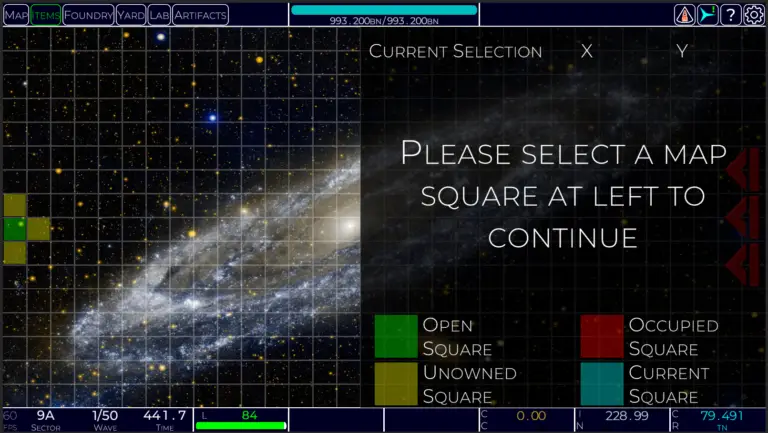
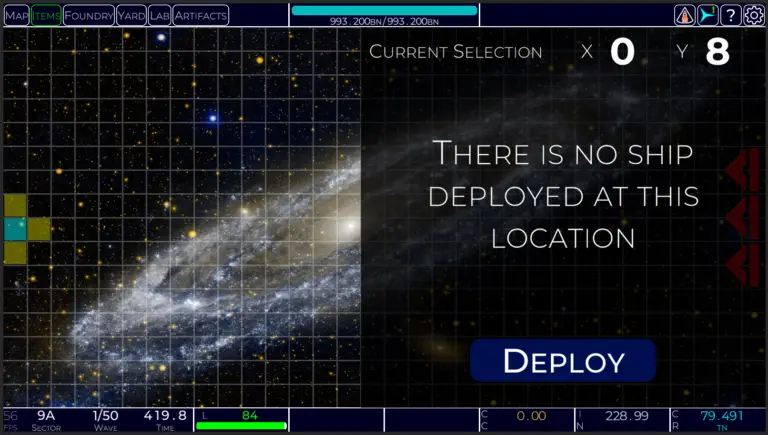
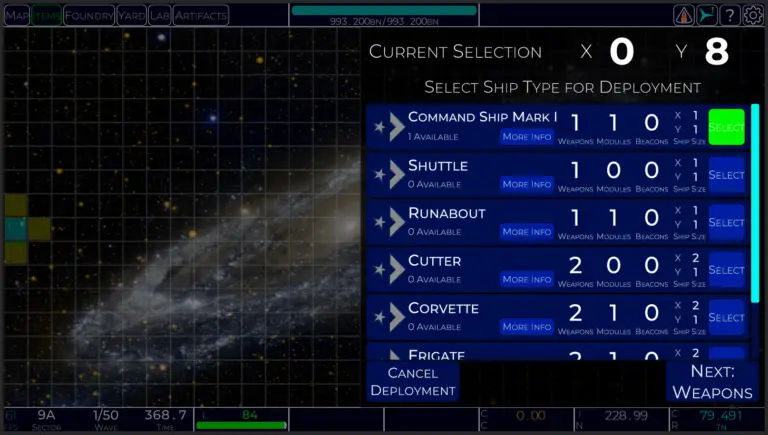
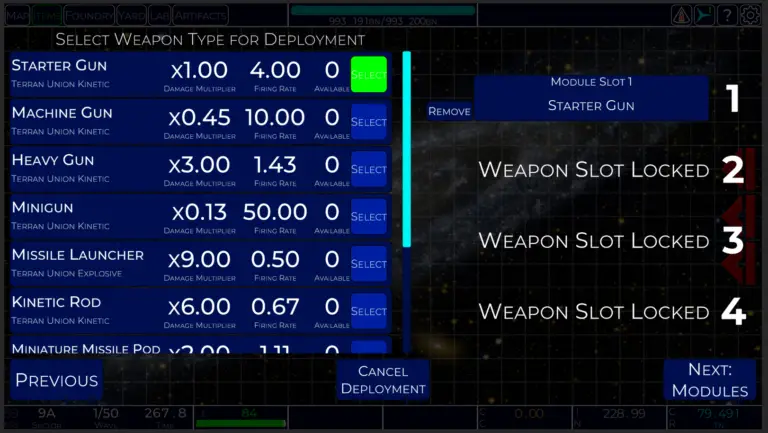
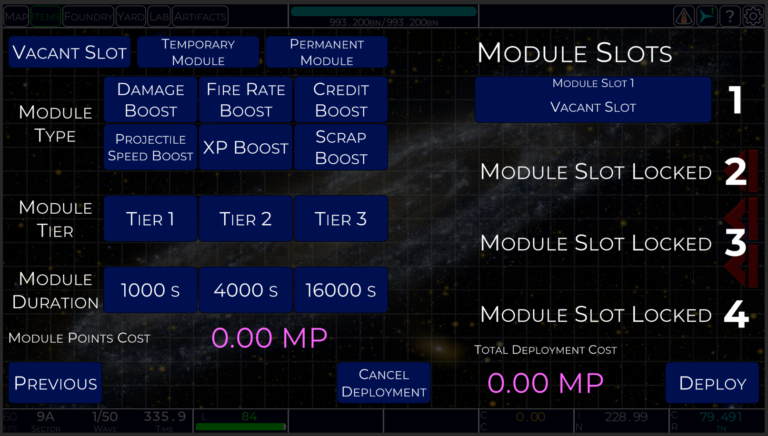
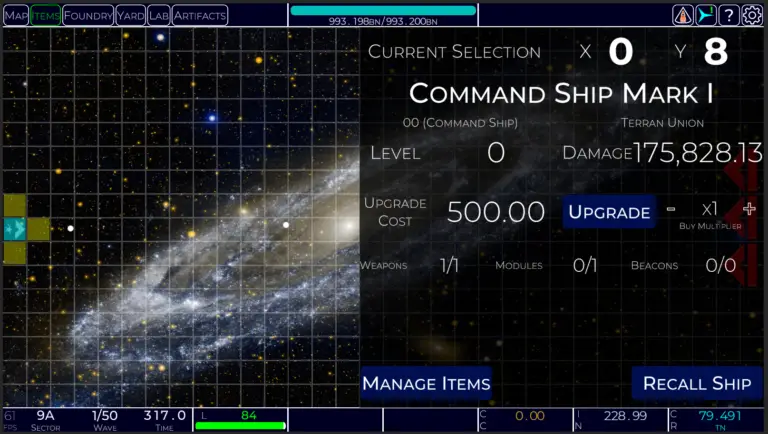
In 0.09.5 and before, you’d have long lists of every individual item. It was easy to get cluttered, or even get item overload. The limitation of modules to 240 helped this, but more was needed to help organize the list.
Initially, a thought was given toward being able to sell old items, but old items will actually be useful in the Contracts system coming in future versions, so I was hesitant to include this kind of system in 0.10. However, what’s changed in 0.10 is that deployment of items is now managed type by type. Instead of having a list of every single Cutter or Frigate you own, you’ll simply have X Cutters and Y Frigates in the deployment system, and you can deploy and recall them with single clicks.
The Deployment Center is now much easier to use as well. Instead of deploying every single item individually, you package up a whole ship – including its weapons and modules – and deploy it all at once, and then you can manage a ship’s items from the same parts of the Deployment Center. This creates a much more unified and easy to use interface, speeding up deployments.
One significant change is to Temporary Modules – they’re deploy and done instead of being recallable. The Module Points spent on them aren’t refundable either – once placed, they stay placed, and are destroyed if the ship is recalled.
Module Points?
Instead of endless strings of module items, you now can pick Modules out a la carte. To do this, Module rewards are replaced with Module Points, which are spent in the Deployment Center to place Temporary Modules. A new resource icon is being added to the Resource Bar to show how many Module Points you have on hand.
The Commonwealth of Isara

With 9 new Artifact upgrades, the Isarans will boost Credits, CC collections, and Laser weapons.
Milestones BETA

One of the most requested new items has been an achievement system. While I’m still working out just how I want this to look, I’ve decided to start testing with a few of what I’m calling “Milestones”. These are one-time achievements that will reward Neutronium or Neutron Stars for reaching them. They’re not affected by any form of reset. While I don’t think these will be the final forms these achievements will take, I wanted to start to roll something out.
Once Milestones are more finalized, they’ll be the basis for ISN’s Steam Achievements. Also, in future, there will be “Goals” – repeatable achievements which reset on Calibration, Artifact collection, or other such resets. More on these in future versions.
UI Overhaul, Part III: Yard, Lab, & Artifacts Screens Refined
The other portion of UI Overhaul III (aside from the new Items System and Deployment Center) is a series of refinements to the Yard, Lab, and Artifacts UIs. A lot of this was just formatting updates (rearranging some blocks so their contents don’t run into each other), but one major upgrade is that locked items – instead of being hidden – will now show their unlock conditions. This way, players can see the content they have yet to unlock instead of just being in the dark. (You can see an example of this on the screenshot of the Isarans’ Artifact upgrades.)
Another fix is that upgrades relating to ore and asteroids are currently hidden, as those systems are disabled pending their upcoming rework in 0.11.
Finally, scrollbars have been yelled at to have the top be at the top, and hopefully all start at the top as well.
More Rebalances & Systems Updates
The Foundry Automate, which will upgrade your Scrap Refinery automatically, has been added and is unlockable for 100 CC.
Daily Rewards can be collected after 22 hours instead of 24. Additionally, both they and Offline Progress produce visual alerts on screen, and Daily Rewards will check if they can be collected every hour in order to ensure you never miss another Daily Reward.
The Information Codex has been updated and slightly expanded. The Tutorial was revised and shrank slightly to match with the new Deployment Center.
The Lab Time Bonus base amount has been reduced from 0.004 per minute to 0.0025 per minute, and its maximum time has been extended from 600 minutes to 1000. Additionally, offline time now counts toward this progression in part.
Ships have been rebalanced to ensure more ships than the Command Ship Mark I are useful, as discussed in Devnote XXXVI.
The Future of ISN is Now
With the release of 0.10.0, Idle Space Navy will be much closer to the original vision I had for the Steam release.
I do want to thank those of you who’ve stuck with the game and given it your feedback since the release of 0.07.4 last year. While it hasn’t been as smooth as I thought, mostly because I didn’t think of a lot of the stuff that had come up as people played with the game, I genuinely think ISN is reaching a point where people can reliably enjoy it.
For those of you who’ve put aside the game, I am hopeful that 0.10.0 will convince you to give it a second look. The game is much refined from its unbalanced version first presented, and the future of Idle Space Navy beyond 0.10 is looking bright indeed.
Thank you for reading this extra-long devnote, and I look forward to seeing you in Saturday’s stream as well as the future of Idle Space Navy!
Idle Space Navy Devnote XXXVI

Greetings, Commanders!
There’s been precious little news since Devnote XXXV kicking off 0.10’s development, and there’s been a major reason for this: My vertigo from 2021-22 has recurred, and at the same time as I’m suffering from an as yet undiagnosed stomach ailment. I’m scheduled for a doctor appointment on Monday, so we’ll see how soon I can get better and get back to full speed.
However, work (especially planning behind the scenes) on Idle Space Navy 0.10.0 has been proceeding, albeit at a much slower pace than I would like. I’m close to being able to get back to full speed, so I should cover some of what I’m working on. Brace for a wall of text.
The Ship Rebalance
One of the perennial issues with ISN’s balancing has been the fact that ships don’t balance well. More specifically, the Command Ship Mark I (CS I) is so overpowered related to other ships especially at high levels that they really don’t compare well.
This will change quite dramatically in 0.10.0, and here’s how. At first, when you log into 0.10.0, it may look like several of your ships have been nerfed, although some may also appear to be buffed.
What’s actually happened is that they’ve been rebalanced against the CS I. Basically, I did some complicated math to get the damage and per-level cost of the CS I at a particular level, and then balanced each ship to be a certain percentage of that damage at equivalent per-level cost. As an example, the Shuttle (and Runabout) have been balanced against a CS I at level 5000 – a Shuttle at level 5027 will have roughly 20% of the damage of that CS I, and the next level (level 5028) will cost the same as the CS I’s next level. This is ignoring bonuses from putting Calibration Chips into ship levels, but what ships you choose to focus on may change, especially with one of the rebalances being discussed later in this devnote.
For the early ships – up through the Corvette – those ships are balanced low down. They use a CS I level of 5000 for the Shuttle and Runabout, and level 7500 for the Cutter and Corvette, as their balancing targets. These ships will largely be useful to you in the lower levels. Beyond ship level 10000, they start losing ground against the CS I.
On the other hand, the Frigate and Destroyer will start below the CS I, but slowly start to gain ground on it (and would eventually surpass it at extremely high levels). Ships in higher tiers will surpass the CS I outright, and this is the point where you’d be considering replacing the CS I entirely.
tl;dr: Ships other than the CS I will mean something.
Unintended Consequences
So, one of the things that this ship rebalance will affect is that some people who’ve dumped oodles of CC into ships like the Corvette (which used to be the OP ship of choice) will want to push them around. Also, Chips spent in the Lab ship and weapon levels are preserved on Artifact reset – this wasn’t intended, and was an artifact of ships being preserved in Artifact resets as opposed to my original plan to reset everything at that level.
There are two things in 0.10.0 that will impact this. First, all Lab ship levels will be reset to 1 in the next patch. Now, this reset will return those Calibration Chips to you – I’m not just going to rob you of your hard-earned CC.
The second, however, is a significant rebalance of how Lab item levels work: All ship and weapon levels, on Artifact collection, will be reduced to the square root of their current level, rounded down. This means that dumping huge amounts of CC into Lab ship levels right before a collection is no longer going to be nearly as effective.
Now, I understand that this is (in effect) a huge nerf to progress right after an Artifact collection. What’s going to happen to balance this out is that every level lost in these will translate into a series of “catch-up boosts” to things like damage output, fire rate, and XP/credit collection in the earlier levels of the game. These boosts should outweigh in large part (if not entirely) the nerf, and the ship rebalance will make points in other ships more useful.
A few minor tweaks
Daily Rewards have run into a few issues from time drift as well as from the game not checking for rewards if it’s running in the background. In 0.10.0, ISN will check for Daily Rewards every hour (and has a little icon on its menu button to show there’s stuff to collect), and the time when you can start collecting Daily Rewards will be reduced from every 24 hours to every 22 hours.
Sectors cleared doesn’t necessarily (at all – a bit of ISR heritage) line up with sector numbers – this will be included in stats from 0.10.0 onward. It won’t be accurate when you first start the game, but after Lab calibration, you will have an accurate count of sectors completed in each Calibration within the Stats menu.
The New Items System
So, here’s the meat and potatoes of 0.10.0 – the overhaul of the Items System. With items not being reset with every Artifact reset, the items list builds up out of all proportion. There’s going to be a whole new Items System in 0.10.0 to streamline how items are handled.
Putting your stuff management on the Map. For starters, the Items Screen is going to become a direct overlay on the Map, as opposed to a wholly separate screen like Lab or Yard. The Items Screen will contain your Map Squares (with clickable buttons!) on the left, and you’ll interact with the items, Map Squares, and the like on the right side of the screen.
Individual items are being eliminated. The only time you’ll be working with individual items is dealing with active Ships – instead, you’ll be managing your items on a per-type basis. You’ll be able to buy up to a certain number of items of each type (e.g. if your Ship Cap was 10, you could have up to 10 Shuttles, 10 Runabouts, etc. etc. etc.).
When deploying items, you’ll just pick which ship type to deploy, pick the weapon and module types you want to add to it, and then you’re off to the races.
Temporary module items are being replaced with Module Points. Basically, for each Module Slot on Ship deployment, and any time you want to add a new Temporary Module to a module slot, you’ll spend Module Points. Temporary Module types and tiers will be unlockable in the Artifact System – you’ll always have access to craft tier 1 Temporary Modules of all types for the minimum duration (1000 seconds), but higher tiers and longer durations will be unlocked with the various Alien Powers. Your permanent module for Command Center Effectiveness will not be affected, but will simply have a new placement system.
While you can’t sell old Items, don’t fret – they won’t burden your progress anymore, and will be useful going forward! Plus, with these revisions, they’ll be out of the way, too. Old ships and weapons will become useful in the Contracts system, coming in a future version. This will be a system that allows you to obtain resources, unique Items, and other perks – all outside of regular Sector farming!
This devnote is long enough already…
… so there will be more on 0.10.0 coming in Devnote XXXVII at a later date (probably around mid-April). I hope this whets your appetite for the next chapter of Idle Space Navy, and addresses some concerns people have had with the game so far!
Post Archive
- July 2024 (1)
- June 2024 (2)
- May 2024 (1)
- March 2024 (1)
- February 2024 (1)
- January 2024 (3)
- December 2023 (2)
- October 2023 (4)
- September 2023 (5)
